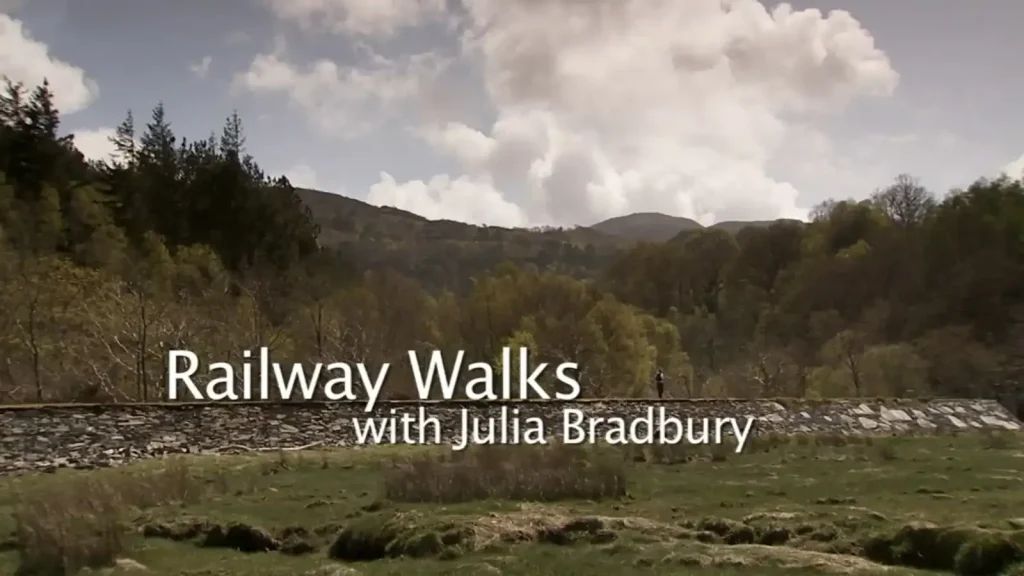Railway Walks with Julia Bradbury episode 1: Julia Bradbury dons her trusty backpack, ready to traverse the breathtaking expanses of Britain’s great outdoors. Her journey takes her on a historical exploration of Britain’s lost railway empire, a network of forgotten tracks and hidden viaducts that once crisscrossed England, Scotland, and Wales. Each of Julia’s walks is a voyage back in time, following overgrown pathways and disused lines that wind through stunning landscapes and the forgotten backstreets of urban centers.
Every route offers its own narrative, revealing a unique slice of industrial Britain. These journeys not only showcase the architectural marvels of the railways but also reflect on the profound impact the rise and fall of these transport arteries have had on local communities and the entire nation.
The series kicks off in the picturesque heart of the Peak District, Derbyshire, where Julia embarks on the beloved Monsal Trail. This trail, known for its captivating natural beauty, features dramatic limestone cliffs and deep gorges. It follows the historical path of the Midland Railway, known as one of the most audacious and spectacular main lines ever constructed. Along this trail, hikers can marvel at the architectural feats of the era, including well-preserved tunnels and the soaring viaducts that once carried countless passengers across the rugged landscapes.
“Railway Walks with Julia Bradbury” Episode 1: “The Peak Express,” introduces viewers to these enchanting routes, blending the thrill of discovery with a deep appreciation for the intricate history interwoven with Britain’s scenic vistas and industrial past. Each episode promises to deliver an insightful look into how transportation molded the United Kingdom’s cultural and physical geography, making Julia’s guided tours not just walks but a profound educational experience.
As the series progresses, Julia delves deeper into the tapestry of Britain’s rail history, unearthing stories that have long been overshadowed by progress and modernity. Her explorations reveal not just the engineering feats but also the societal shifts prompted by the railway’s expansion and eventual decline. Each segment of her journey is carefully chosen to highlight a different aspect of railway heritage, from bustling hubs that have quieted over the decades to serene stretches that nature has almost completely reclaimed.
One poignant episode takes Julia to the verdant valleys of Wales, where she follows the tracks of the Bala Lake Railway. This route showcases the transformative power of railways in remote areas, connecting isolated communities to larger economic centers. Here, the remnants of platforms and rusting signals stand as silent witnesses to a once-bustling line that saw local industries flourish and decline.
Railway Walks with Julia Bradbury episode 1
Moving northward, Julia’s adventures take her to Scotland, where she treks along the iconic West Highland Line. Known for its dramatic vistas, the line offers more than just scenic beauty—it tells a story of survival and adaptation. The line continues to operate, unlike many others, and serves as a lifeline for communities, proving that some of these historic tracks still play a vital role in contemporary life.
In England, Julia explores the haunting beauty of the Cornish coast through the Liskeard and Looe Valley Line. This episode focuses on the small fishing villages that were irrevocably changed by the railway, which brought tourists and new trades but also challenges to traditional ways of life.
Each episode of “Railway Walks with Julia Bradbury” weaves together breathtaking natural scenery with rich historical commentary, making it much more than a simple travelogue. It’s an educational journey that paints a comprehensive picture of how railways shaped the physical and social landscapes of Britain. Through Julia’s eyes, viewers gain an appreciation for the ingenuity and ambition of past generations, and a sense of the profound, lingering impact of their endeavors on the present.
As Julia retraces these old routes, the series not only chronicles the stories of those who built and traveled these railways but also highlights the efforts to preserve these historic lines, whether as bustling modern routes or peaceful walking trails. This deep dive into Britain’s railway legacy offers a unique perspective, connecting viewers to the past in a way that is both informative and deeply moving.
The Hidden Treasures of Britain’s Disused Railways
The legacy of Britain’s rail empire
For over a century, the roar of steam engines and the clatter of wheels on tracks defined the rhythm of life across the British Isles. The railway network, once the lifeblood of a global superpower, wove its way through bustling cities and picturesque countryside alike. This iron web not only connected distant corners of the nation but also shaped its very landscape and society.
However, as the winds of change swept through the 20th century, many of these once-vital arteries fell silent. Today, an astounding 10,000 miles of disused railway lines crisscross the country. Yet, far from being forgotten relics, these abandoned tracks have found a new purpose. They’ve become silent sentinels of history, waiting to be rediscovered by those with a keen eye for adventure and a love of the great outdoors.
The transformation of abandoned lines into walking trails
Like a phoenix rising from the ashes, these forgotten railway lines have been reborn as a network of enchanting walking trails. Where once thundered the engines of progress, now echo the footsteps of hikers and nature enthusiasts. The transformation is nothing short of magical. Embankments that once carried the weight of locomotives now support a vibrant ecosystem of flora and fauna. Old platforms, once teeming with passengers, serve as perfect resting spots for weary walkers.
This metamorphosis has gifted us with a unique perspective on both our industrial heritage and natural beauty. As you traverse these paths, you’re not just taking a stroll; you’re walking through living museums of British history. Every sleeper, every rusted rail, every weathered milestone tells a story of a bygone era. Yet, nature’s reclamation of these spaces also points towards a greener, more sustainable future.
Julia Bradbury’s journey through the Peak District
To truly appreciate the allure of these railway walks, we need look no further than Julia Bradbury’s captivating exploration of the Peak District. Her journey serves as a perfect introduction to the wonders that await along these repurposed tracks. As she sets foot on the Monsal Trail, we’re transported to a world where industrial heritage and natural splendor coexist in perfect harmony.
The Peak District, with its rolling hills and dramatic limestone valleys, provides a stunning backdrop for Bradbury’s adventure. As she follows the path of the old Midland Railway, we’re treated to a visual feast that showcases the best of both worlds. The trail winds its way through tunnels carved by Victorian engineers, across viaducts that still stand as testament to 19th-century ingenuity, and alongside riverbanks teeming with wildlife.
Through Bradbury’s eyes, we see how these railway walks offer more than just exercise; they provide a window into our past and a path to understanding our present. Her journey reminds us that every step taken on these trails is a step through time, connecting us with the generations that came before and the landscape that has shaped our nation.
The Monsal Trail: A Journey Through Time and Nature
The historical significance of the Midland Railway
The ambitious London to Manchester route
When the Victorians set their minds to something, they didn’t do things by halves. The Midland Railway’s ambitious plan to connect London and Manchester was no exception. Picture, if you will, a time when the industrial revolution was in full swing, and the demand for faster, more efficient transport was at its peak. Enter the visionaries of the Midland Railway, who dared to dream of a direct route through the heart of the Peak District.
This wasn’t just any railway line; it was a testament to human ingenuity and determination. The engineers faced a daunting task: how to carve a path through the twisting valleys and rocky hills of Derbyshire. Yet, they persevered, driven by the promise of progress and the potential to revolutionize travel between two of England’s most important cities. The result? A marvel of Victorian engineering that would shape the landscape and the lives of those who lived along its route for generations to come.
Impact on local communities and industry
As the railway snaked its way through the Derbyshire countryside, it brought with it a wave of change that would transform sleepy villages into bustling hubs of activity. Bakewell, once a quiet market town, suddenly found itself just two and a half hours from the heart of London. Meanwhile, the cotton mills of Cressbrook and Litton gained a vital lifeline, connecting them to the wider world and fueling their growth.
But the impact of the Midland Railway wasn’t limited to industry alone. It opened up the breathtaking beauty of the Peak District to a whole new audience. Tourists flocked to the area, drawn by the promise of fresh air and stunning vistas. Local events, like the Bakewell Show, grew from modest gatherings to grand affairs, attracting visitors from as far afield as Newcastle and Leicester. The railway didn’t just transport goods and people; it carried ideas, culture, and opportunity, breathing new life into the communities along its route.
Engineering marvels along the trail
Monsal Viaduct: A Victorian masterpiece
Standing proudly above the River Wye, the Monsal Viaduct is more than just a bridge; it’s a work of art in stone and mortar. As you approach it along the trail, the viaduct reveals itself gradually, its graceful arches framing the lush greenery of the valley below. It’s a sight that stops hikers in their tracks, cameras at the ready, eager to capture the perfect shot.
But the true magic of the Monsal Viaduct lies in its ability to transport us back in time. Close your eyes, and you can almost hear the whistle of a steam engine, feel the rumble of carriages passing overhead. This isn’t just a relic of the past; it’s a living connection to our industrial heritage. Today, it stands as a testament to the skill and vision of those Victorian engineers who dared to dream big, their legacy etched in every carefully placed stone.
Headstone Tunnel: A subterranean adventure
For those with a taste for adventure, the Headstone Tunnel offers a thrilling journey into the heart of the Peak District. As you step into its cool, dimly lit confines, you’re walking in the footsteps of countless trains and passengers who came before. The tunnel stretches out before you, a 533-yard testament to human perseverance and engineering prowess.
Inside, the atmosphere is electric with echoes of the past. The high, vaulted ceiling and wide passages speak to the grand scale of Victorian ambition. Safety niches, once refuges for railway workers, now serve as reminders of the daily dangers faced by those who kept the trains running. As you emerge on the other side, blinking in the sudden sunlight, you can’t help but feel a sense of accomplishment. You’ve not just walked through a tunnel; you’ve traveled through time itself.
Natural wonders of the Wye Valley
Limestone landscapes and scenic beauty
The Wye Valley, with its dramatic limestone cliffs and verdant meadows, provides a stunning backdrop to the Monsal Trail. As you walk, you’re treated to an ever-changing panorama of natural beauty. The white limestone cliffs rise majestically on either side, their rugged faces softened by pockets of greenery clinging tenaciously to every crack and crevice.
In spring and summer, the valley bursts into life. Wildflowers carpet the meadows in a riot of color, while butterflies dance on the warm breeze. The air is filled with the sweet scent of honeysuckle and the melodious songs of countless birds. It’s a sensory feast, a reminder of the incredible diversity of life that thrives in this unique ecosystem. Every turn in the trail reveals a new vista, each more breathtaking than the last.
The River Wye: A haven for trout and wildlife
Meandering through the heart of the valley, the River Wye is the lifeblood of this remarkable landscape. Its crystal-clear waters are home to a thriving population of wild trout, making it a magnet for anglers from far and wide. But you don’t need a fishing rod to appreciate the river’s charms. As you follow the trail alongside its banks, keep your eyes peeled for the flash of a kingfisher or the playful antics of otters.
The river’s influence extends far beyond its banks. It has shaped the landscape over millennia, carving out the deep valleys and creating the perfect conditions for the diverse flora and fauna that call this place home. From the delicate water crowfoot swaying gently in the current to the stately herons standing sentinel on the shore, the River Wye supports a complex web of life. It’s a living, breathing ecosystem, a reminder of the delicate balance of nature and our role in preserving it for future generations.
From Industrial Powerhouse to Peaceful Paradise
The rise and fall of the cotton mills
Cressbrook and Litton: Tales of two mills
Nestled in the heart of the Wye Valley, Cressbrook and Litton stand as silent sentinels to a bygone era. These once-bustling cotton mills, now peaceful relics, tell a story of industrial might and human perseverance. As you approach Cressbrook, the imposing stone buildings loom large, their weathered facades a testament to the passage of time.
In their heyday, these mills were the lifeblood of the valley. The rhythmic clatter of looms and the hum of machinery filled the air from dawn to dusk. Workers, some as young as children, toiled long hours to produce the fine cotton that helped clothe an empire. Yet, the story of these mills is not just one of production; it’s a tale of community, of families bound together by shared hardship and shared triumphs. Today, as you wander through the tranquil grounds, it’s hard to imagine the bustle and noise that once defined this place.
The railway’s role in industrial growth
The arrival of the Midland Railway breathed new life into these industrial hubs. Suddenly, the isolated valley was connected to the wider world. Raw materials flowed in, finished products flowed out, and the mills flourished. The railway didn’t just transport goods; it brought people too. Workers from as far as London would arrive each week, transforming the quiet Derbyshire countryside into a melting pot of accents and cultures.
But the railway’s impact wasn’t limited to the mills alone. It opened up new possibilities for the entire region. Local farmers found new markets for their produce, while quarries could now ship their limestone to distant cities. The railway was more than just a means of transport; it was the catalyst that propelled the Peak District into the industrial age. As you walk along the old railway line, now a peaceful trail, you’re treading the same path that once carried the lifeblood of this industrial powerhouse.
The transformation of Miller’s Dale Station
From bustling hub to serene walking spot
Miller’s Dale Station once echoed with the shrill whistle of steam engines and the excited chatter of passengers. As the largest station on this stretch of the Midland Railway, it was a hive of activity. Five platforms accommodated the constant flow of express trains, local services, and freight wagons. Today, the scene couldn’t be more different. The platforms, once trod by thousands of feet, now serve as peaceful vantage points for walkers and nature enthusiasts.
The transformation of Miller’s Dale is nothing short of remarkable. Where once stood ticket offices and waiting rooms, wildflowers now bloom in abundance. The air, once thick with coal smoke, is now crisp and clean, filled with the song of birds and the rustle of leaves. It’s a place where you can pause, catch your breath, and marvel at the way nature has reclaimed what was once a monument to human industry. The station’s metamorphosis serves as a poignant reminder of the ever-changing face of our landscape.
The double viaduct: A testament to past glory
Perhaps the most striking feature of Miller’s Dale is its impressive double viaduct. These two parallel structures, spanning the river below, are a vivid illustration of the railway’s former importance. The older viaduct, built in the 1860s, couldn’t cope with the increasing traffic by the turn of the century. Rather than replace it, engineers simply built a second viaduct alongside it in 1905, doubling the line’s capacity.
Today, these twin viaducts stand as a dramatic backdrop to the peaceful valley. Their graceful arches, weathered by over a century of Derbyshire’s notoriously changeable weather, are a favorite subject for photographers and artists alike. As you stand on the viaduct, gazing out over the valley, it’s easy to imagine the thunderous roar of express trains passing overhead. The double viaduct is more than just a scenic feature; it’s a tangible link to our industrial past, a reminder of the ingenuity and ambition that shaped this landscape.
The enduring appeal of the Peak District
Chee Dale: A walker’s paradise
As the Monsal Trail winds its way towards Buxton, it enters the dramatic landscape of Chee Dale. Here, the path leaves the old railway line, plunging into a world of towering limestone cliffs and crystal-clear rivers. Chee Dale is nature at its most raw and beautiful, a place where the power of geological forces is on full display. The narrow path hugs the riverbank, sometimes clinging precariously to the cliff face, offering walkers an exhilarating and unforgettable experience.
In spring and summer, Chee Dale bursts into life. The limestone cliffs provide a perfect habitat for rare wildflowers, their delicate blooms adding splashes of color to the grey rock faces. Keep your eyes peeled for the fluttering wings of the Duke of Burgundy butterfly, one of Britain’s rarest species, which finds sanctuary in these sheltered valleys. As you navigate the twisting path, each turn reveals a new vista, each more breathtaking than the last. It’s no wonder that Chee Dale has become a favorite spot for walkers, nature lovers, and anyone seeking to escape the hustle and bustle of modern life.
The modern uses of former railway infrastructure
The ingenuity of the Victorian railway builders hasn’t been lost on modern adventurers. Today, the impressive viaducts and bridges that once carried trains high above the valleys serve a new purpose. Rock climbers and abseilers have discovered that these structures offer unique challenges and thrilling experiences. On any given weekend, you might spot colorful ropes dangling from the viaducts, as adrenaline junkies test their skills against the weathered stonework.
But it’s not just thrill-seekers who benefit from this repurposed infrastructure. The old railway tunnels, once dark and foreboding, now serve as vital habitats for various species of bats. These protected creatures find sanctuary in the cool, quiet confines of the tunnels, undisturbed by the walkers passing by on the trail above. It’s a perfect example of how nature and human history can coexist, each enriching the other. The railway might be gone, but its legacy lives on, providing new opportunities for both wildlife and humans to thrive in this remarkable landscape.
4. FAQs: Railway Walks with Julia Bradbury episode 1
What is the Monsal Trail and how long is it?
The Monsal Trail is a gem nestled in the heart of the Peak District, offering a unique blend of natural beauty and industrial heritage. This former railway line, now transformed into a picturesque walking and cycling path, stretches for 8.5 miles from Bakewell to Blackwell Mill, near Buxton. As you traverse this trail, you’re not just taking a stroll; you’re walking through history.
The trail follows the route of the old Midland Railway, which once thundered through the Derbyshire dales. Today, it offers a peaceful journey through some of England’s most stunning countryside. Along the way, you’ll encounter impressive viaducts, travel through tunnels, and witness breathtaking views of the Wye Valley. Whether you’re a casual walker, an avid cyclist, or a history enthusiast, the Monsal Trail provides an unforgettable experience that caters to all interests and fitness levels.
Are there any restrictions or safety concerns when walking on former railway lines?
While railway walks offer unique experiences, it’s important to remember that they come with their own set of considerations. Firstly, most railway walks, including the Monsal Trail, are shared paths. This means you’ll need to be aware of cyclists and horse riders who may also be using the trail. Always keep to the left and be prepared to step aside when necessary.
Some sections of former railway lines may still have operational tunnels or bridges. On the Monsal Trail, for instance, several tunnels have been reopened for public use, but they’re unlit. Therefore, it’s advisable to bring a torch if you plan to explore these. Additionally, while the path is generally well-maintained, it can become slippery in wet weather. Proper footwear is essential, especially if you plan to venture off the main trail to explore the surrounding countryside.
How has the closure of railways affected local communities in the Peak District?
The closure of railways in the Peak District, as in many parts of Britain, brought significant changes to local communities. Initially, these closures, part of the infamous Beeching cuts of the 1960s, were met with dismay. Many villages lost their direct connection to larger towns and cities, impacting local businesses and employment opportunities.
However, over time, communities have adapted and found new ways to thrive. The conversion of former railway lines into walking and cycling trails has brought a new type of visitor to the area. Towns like Bakewell, once railway hubs, have reinvented themselves as tourist destinations. Local businesses now cater to walkers, cyclists, and nature enthusiasts, providing accommodation, eateries, and outdoor equipment shops. While the loss of the railways was undoubtedly a challenge, it has, in many ways, allowed these communities to forge a new identity centered around sustainable tourism and outdoor recreation.
What wildlife can be observed along the Monsal Trail?
The Monsal Trail is a haven for wildlife enthusiasts, offering a diverse array of flora and fauna throughout the seasons. As you traverse the trail, keep your eyes peeled for the flash of a kingfisher diving into the River Wye, or the graceful flight of a heron. The limestone cliffs that flank much of the trail provide perfect nesting sites for peregrine falcons, while the meadows buzz with the activity of various butterflies and bees.
In the spring and summer, the trail comes alive with wildflowers. Look out for the delicate blooms of orchids in the limestone grasslands, or the vibrant yellow of cowslips. The old railway embankments have become linear nature reserves, supporting a rich diversity of plant life. As autumn approaches, the woodland sections of the trail burst into a riot of color, and you might spot red deer in the quieter areas. Even in winter, the trail offers wildlife spotting opportunities, with resident birds like dippers and wagtails often seen along the river.
Are there any preserved sections of the original railway on the trail?
While the Monsal Trail has been repurposed for walking and cycling, numerous remnants of its railway past remain, offering fascinating glimpses into Britain’s industrial heritage. Perhaps the most striking features are the imposing viaducts that span the valleys. The Monsal Dale Viaduct, with its five magnificent arches, stands as a testament to Victorian engineering prowess and provides spectacular views of the surrounding landscape.
Throughout the trail, you’ll encounter other preserved elements of the original railway. Look out for old station platforms, now peaceful spots to pause and take in the scenery. At Millers Dale, you can see the remains of what was once the largest station on the line, including its rare double viaduct. Signal boxes, mile markers, and gradient posts can also be spotted along the way. These preserved features serve as a tangible link to the past, allowing visitors to imagine the bustling railway that once passed through this tranquil landscape.
5. Conclusion: The Rebirth of Britain’s Railway Heritage
5.1. The transformation of industrial relics into natural treasures
As we’ve journeyed along the Monsal Trail, we’ve witnessed a remarkable metamorphosis. What was once a bustling railway line, pulsing with the lifeblood of industry, has blossomed into a verdant corridor of natural beauty. This transformation is nothing short of magical, akin to a butterfly emerging from its chrysalis. The very tracks that once carried coal and cotton now support a thriving ecosystem of flora and fauna.
Consider the viaducts, those towering sentinels of Victorian engineering. Once they trembled under the weight of steam locomotives; now they stand in silent majesty, framing breathtaking vistas of the Derbyshire dales. Nature, ever the opportunist, has reclaimed these structures. Wildflowers peek out from cracks in the stonework, while birds nest in nooks once occupied by signal boxes. It’s as if the landscape has woven these industrial relics into its fabric, creating a seamless tapestry of man-made and natural wonders.
5.2. The importance of preserving railway history for future generations
While we revel in the natural beauty of these reclaimed spaces, we must not forget the rich history they embody. These former railway lines are more than just picturesque walking trails; they’re living museums, chronicling a pivotal chapter in Britain’s industrial past. By preserving these sites, we’re not just safeguarding bricks and mortar; we’re keeping alive the stories of the men and women who built and worked on these railways.
Imagine a child walking the Monsal Trail, their imagination fired by the sight of a tunnel mouth or an old station platform. These tangible links to the past have the power to inspire curiosity about history in ways that textbooks never could. Moreover, they serve as a reminder of human ingenuity and the incredible feats of engineering that shaped our landscape. By maintaining these historical features, we’re providing future generations with a window into a world that shaped modern Britain.
5.3. Encouraging exploration of Britain’s extensive network of railway walks
The Monsal Trail is just one gem in a vast network of railway walks crisscrossing Britain. From the rugged coastlines of Cornwall to the rolling hills of Scotland, these paths offer a unique way to experience the country’s diverse landscapes. They’re not just routes from A to B; they’re gateways to adventure, portals to the past, and bridges between communities.
So, lace up your walking boots, grab your bicycle, or saddle up your horse. These trails are calling, beckoning you to explore the hidden corners of Britain. With each step, pedal, or trot, you’ll be tracing the footsteps of history, following routes that once hummed with the energy of the industrial revolution. You’ll discover quaint villages, stumble upon stunning viewpoints, and perhaps even uncover a part of yourself you never knew existed.
Remember, every journey begins with a single step. Whether you’re a seasoned hiker or a casual Sunday stroller, there’s a railway walk out there waiting for you. So why not make your next adventure a journey through Britain’s railway heritage? Who knows what wonders you might discover along the way? After all, sometimes the most extraordinary destinations are hidden in the most ordinary of places – like an old, forgotten railway line.




